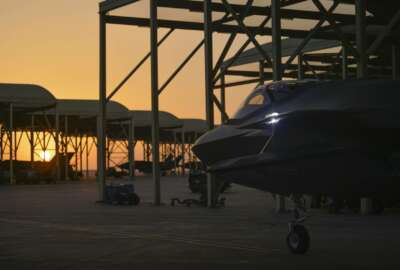

If it could, the Air Force would prefer to have airmen and guardians only perform the work they need to do – and find other solutions where possible.
If it could, the Air Force would prefer to have airmen and guardians only perform the work they need to do – and find other solutions where possible. This presents a major industry partnership opportunity, according to two of the military branch’s technology leaders.
Since 2017 the Air Force has been examining risk reduction which, as Col. Bobby King, senior materiel leader for the enterprise IT and cyber infrastructure division, told Federal News Network, is divided up into three lines of effort: network-as-a-service, end user services, and compute and store. The Air Force awarded other transaction agreements to Microsoft and AT&T to provide commercial solutions for network as a service in 2018.
The end user services line of effort refers to everything that airmen and guardians will interact with, from the endpoint, the operating system and security tools on that endpoint, and the enterprise or local help desks.
As for the “computer and store” line of effort, King said in a continuation of the interview, the Air Force has a Cloud One program as well as 74 live mission systems.
“There’s some elements to working with the cloud that we wanted to explore in a risk reduction effort to augment and improve that enterprise-provided cloud – Cloud One,” he said on Federal Monthly Insights – Digital Modernization: Enterprise Modernization. “And so we awarded an OTA for compute and store. And the idea there was to have a single pane of glass that allows the vendor partner and the Department of the Air Force to see everything going on in the cloud, and as well as get after the on-prem, disconnected ops-types requirements that were provided to us from our lead [major command] – Air Combat Command.”
But how does the Air Force conclude what is a good user experience?
Maj. Gen. Michael Schmidt – program executive officer for the Command, Control, Communication, Intelligence, and Networks (PEOCIN) at Hanscom Air Force Base, Massachusetts, said that what is right for an airman at one base might not support the mission at another base if the technology needs are different.
“I would say we are trying to capture the enterprise level requirements, that would be the common denominator in general across all bases at the same time, [King] has a number of teams – actually, we do both on Bobby’s collateral side and our on our classified side of going out and right now, we’re doing these [Advanced Battle Management System] experiments or [joint all-domain command and control] demonstrations at various places around the world,” Schmidt said on Federal Drive with Tom Temin. “And we’re sending our teams out to really, if you will, help trick out those bases, even though they might not be risk reduction bases for [enterprise IT as a service].”
Schmidt said the Air Force knows which bases have “kind of an ancient infrastructure” relative to their data needs and mission requirements. The service sends teams to help each base individually, rather than on a per-experiment basis. He said having those teams of people who know the true ins and outs of the Air Force’s IT infrastructures and be hands-on has proven to be the most effective method.
“And we’re really seeing some quick wins at some of these bases that we didn’t get – maybe we didn’t know before, why they seem to have so many problems?” he said. “So it’s been really helpful tying ABMS or JADC2 experiments or demonstrations to some of our IT infrastructure, things that we’re trying to get after.”
Copyright © 2025 Federal News Network. All rights reserved. This website is not intended for users located within the European Economic Area.
Amelia Brust is a digital editor at Federal News Network.
Follow @abrustWFED


